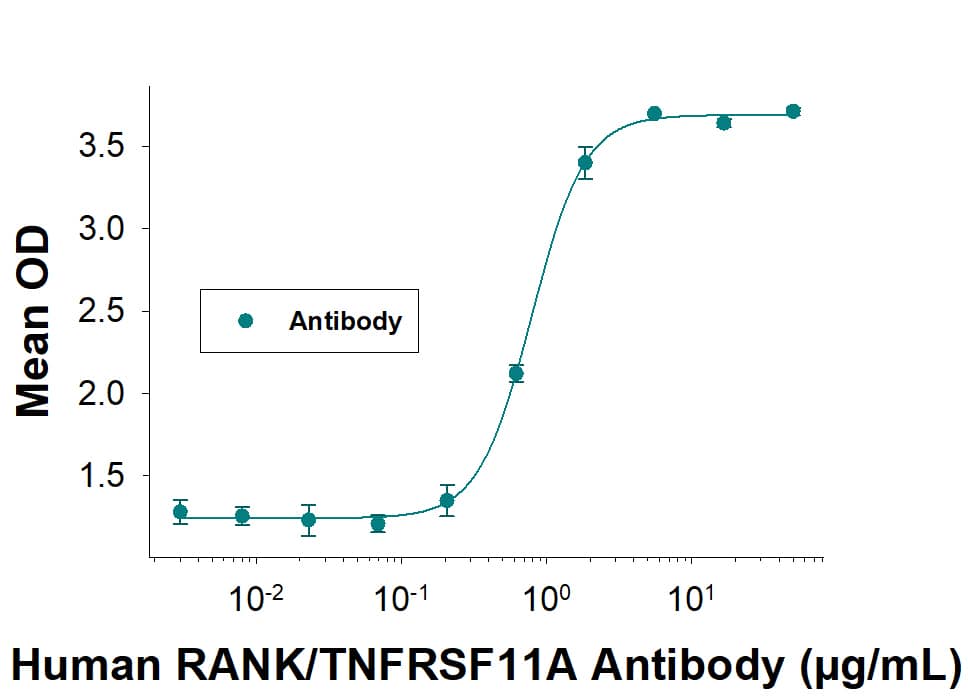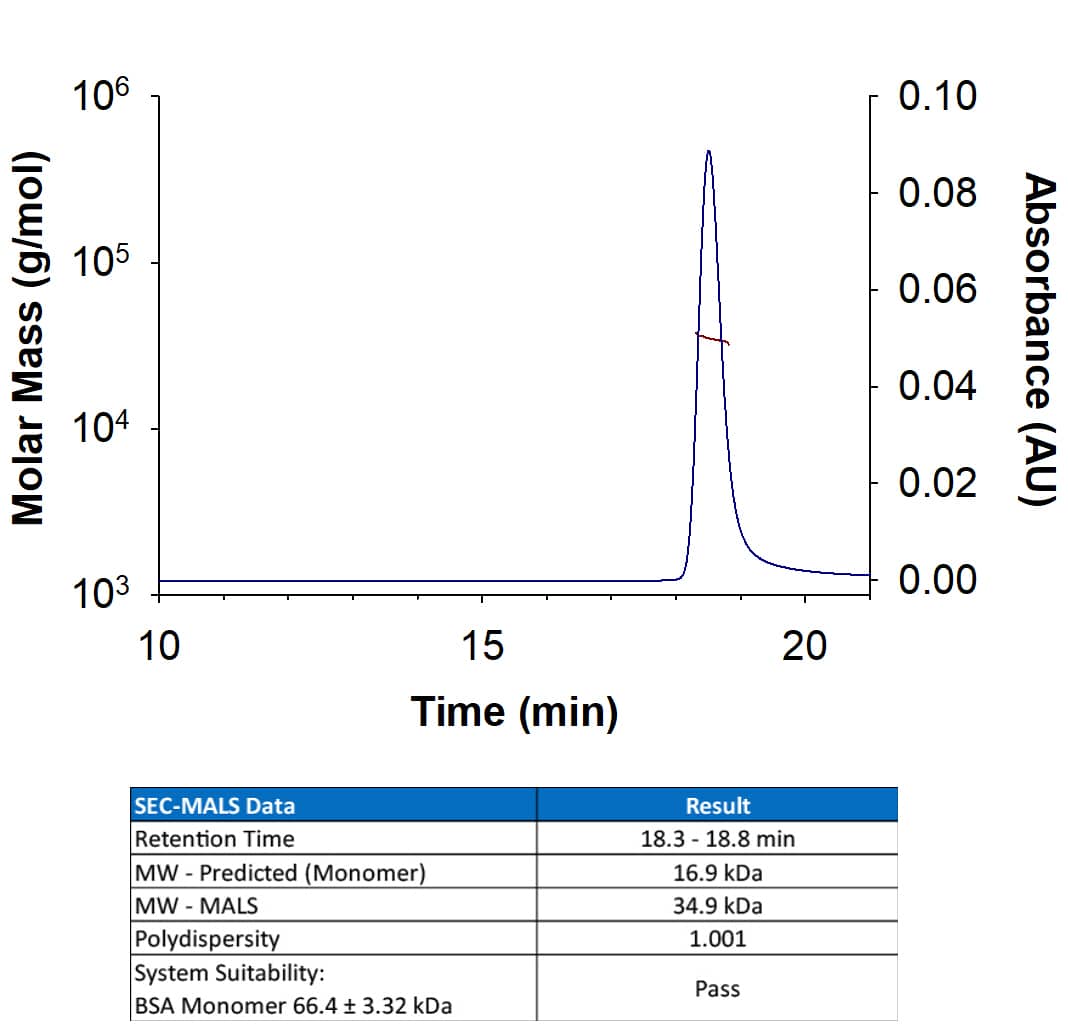Recombinant Rat TRANCE/RANK L/TNFSF11 Protein
Recombinant Rat TRANCE/RANK L/TNFSF11 Protein Summary
Product Specifications
Arg72-Asp318, with an N-terminal 6-His tag
Analysis
Customers also Viewed
Product Datasheets
Carrier Free
CF stands for Carrier Free (CF). We typically add Bovine Serum Albumin (BSA) as a carrier protein to our recombinant proteins. Adding a carrier protein enhances protein stability, increases shelf-life, and allows the recombinant protein to be stored at a more dilute concentration. The carrier free version does not contain BSA.
In general, we advise purchasing the recombinant protein with BSA for use in cell or tissue culture, or as an ELISA standard. In contrast, the carrier free protein is recommended for applications, in which the presence of BSA could interfere.
9366-TN
| Formulation | Lyophilized from a 0.2 μm filtered solution in NaH2PO4, NaCl and EDTA with BSA as a carrier protein. |
| Reconstitution | Reconstitute at 100 μg/mL in PBS containing at least 0.1% human or bovine serum albumin. |
| Shipping | The product is shipped at ambient temperature. Upon receipt, store it immediately at the temperature recommended below. |
| Stability & Storage: | Use a manual defrost freezer and avoid repeated freeze-thaw cycles.
|
9366-TN/CF
| Formulation | Lyophilized from a 0.2 μm filtered solution in NaH2PO4, NaCl and EDTA. |
| Reconstitution | Reconstitute at 100 μg/mL in PBS. |
| Shipping | The product is shipped at ambient temperature. Upon receipt, store it immediately at the temperature recommended below. |
| Stability & Storage: | Use a manual defrost freezer and avoid repeated freeze-thaw cycles.
|
Scientific Data
 View Larger
View Larger
Recombinant Rat Trance/RANK L/ TNFSF11 (Catalog # 9366-TN) Induces Osteoclast Differentiation of the RAW 264.7 Mouse Monocyte/Macrophage Cell Line. The ED50 for this effect is 2.5-15 ng/mL in the presence of 2.5 µg/mL of a cross-linking antibody, Mouse Anti-polyHistidine Monoclonal Antibody (Catalog # MAB050R).
Background: TRANCE/TNFSF11/RANK L
RANK L (receptor activator of NF-kappa B ligand), also called TRANCE (TNF-related activation-induced cytokines), OPGL (osteoprotegerin ligand), or ODF (osteoclast differentiation factor), is a 39-45 kDa type II transmembrane (TM) protein in the tumor necrosis factor family, designated TNFSF11 (1-5). RANK L, produced by osteoblasts and bone marrow stromal cells, is required for differentiation of osteoclasts and stimulates bone resorption (4, 6). It is also produced by activated T cells and augments dendritic cell stimulation; RANK L-/- mice lack lymph nodes and have impaired thymocyte development (1-3, 6). The rat RANK Ligand cDNA encodes a type II transmembrane protein of 318 amino acids with a predicted cytoplasmic domain of 47 amino acids, a 21 amino acids transmembrane region, and an extracellular domain of 250 amino acids. The extracellular domain contains two potential N-linked glycosylation sites. Rat and human RANK Ligand and rat and mouse RANK Ligand share 83% and 95% amino acid identity respectively. RANK L can stimulate human osteoclast differentiation (4). Like most TNF family members, RANK L can form trimers (1). Soluble 31, 25 and 24 kDa forms of RANK L can be created by usage of alternate start sites at aa 74 or 146, or proteolytic cleavage by osteoblast- or stromal cell-derived ADAM10 (after aa 139) or MMP14 (aa 146), or bone metastatic prostate tumor-derived MT1-MMP (aa 146) (5, 7, 8). Both TM and soluble extracellular RANK L act by engaging RANK receptors and are antagonized by the decoy receptor, OPG (osteoprotegrin) (2, 5). In resting cells, the majority of RANK L is stored in secretory lysosomes (9). In mammary epithelia, RANK L is up-regulated by pregnancy hormones and is essential for the formation of a lactating mammary gland (10). In the brain, astrocyte RANK L mediates body temperature regulation (11). Pathologically, RANK L is thought to mediate post-menopausal osteoporosis, vascular calcification, progestin-induced breast cancer, cancer-induced bone disease, and osteopetrosis (in RANK L deficiencies) (12-16).
- Leibbrandt, A. and J.M. Penninger 2008) Ann. N. Y. Acad. Sci. 1143:123.
- Wong, B.R. et al. (1997) J. Biol. Chem. 272:25190.
- Anderson, D.M. et al. (1997) Nature 390:175.
- Lacey, D.L. et al. (1998) Cell 93:165.
- Hikita, A. et al. (2006) J. Biol. Chem. 281:36846.
- Kong, Y-Y. et al. (1999) Nature 397:315.
- Accession # NP_143026 and EAX08679.
- Sabbota, A.L. et al. (2010) Cancer Res. 70:5558.
- Aoki, S. et al. (2010) J. Bone Miner. Res. 25:1907.
- Fata, J.E. et al. (2000) Cell 103:41.
- Hanada, R. et al. (2009) Nature 462:505.
- Osako, M.K. et al. (2010) Circ. Res. 107:466.
- Schramek, D. et al. (2010) Nature 468:98.
- Gonzalez-Suarez, E. et al. (2010) Nature 468:103.
- Dougall, W.C. and M. Chaisson (2006) Cancer Metastasis Rev. 25:541.
- Sobacchi, C. et al. (2007) Nat. Genet. 39:960.
Citations for Recombinant Rat TRANCE/RANK L/TNFSF11 Protein
R&D Systems personnel manually curate a database that contains references using R&D Systems products. The data collected includes not only links to publications in PubMed, but also provides information about sample types, species, and experimental conditions.
5
Citations: Showing 1 - 5
Filter your results:
Filter by:
-
14-3-3? Suppresses RANKL Signaling by Destabilizing TRAF6
Authors: Ayyasamy, R;Fan, S;Czernik, P;Lecka-Czernik, B;Chattopadhyay, S;Chakravarti, R;
The Journal of biological chemistry
Species: Rat
Sample Types: Whole Cells
Applications: Bioassay -
Dual Role of Interleukin-20 in Different Stages of Osteoclast Differentiation and Its Osteoimmune Regulation during Alveolar Bone Remodeling
Authors: B Meng, B Yang, Y Qu, Y Liu, D Wu, C Fu, Y He, X Chen, C Liu, X Kou, Y Cao
International Journal of Molecular Sciences, 2023-02-14;24(4):.
Species: Rat
Sample Types: Whole Cells
Applications: Bioassay -
Interleukin-20 Acts as a Promotor of Osteoclastogenesis and Orthodontic Tooth Movement
Authors: Y Liu, Y Ai, X Sun, B Meng, X Chen, D Wu, L Gan, B Yang, C Fu, Y Wu, Y Cao
Stem Cells International, 2021-05-26;2021(0):5539962.
Species: Rat
Sample Types: Whole Cells
Applications: Bioassay -
Alendronate loaded graphene oxide functionalized collagen sponge for the dual effects of osteogenesis and anti-osteoclastogenesis in osteoporotic rats
Authors: Y Zeng, M Zhou, L Chen, H Fang, S Liu, C Zhou, J Sun, Z Wang
Bioact Mater, 2020-06-25;5(4):859-870.
Species: Rat
Sample Types: Whole Cells
Applications: Cell Culture -
Microporous polysaccharide multilayer coated BCP composite scaffolds with immobilised calcitriol promote osteoporotic bone regeneration both in vitro and in vivo
Authors: Q Tang, Z Hu, H Jin, G Zheng, X Yu, G Wu, H Liu, Z Zhu, H Xu, C Zhang, L Shen
Theranostics, 2019-01-30;9(4):1125-1143.
Species: Rat
Sample Types: Whole Cells
Applications: Bioassay
FAQs
No product specific FAQs exist for this product, however you may
View all Proteins and Enzyme FAQsReviews for Recombinant Rat TRANCE/RANK L/TNFSF11 Protein
There are currently no reviews for this product. Be the first to review Recombinant Rat TRANCE/RANK L/TNFSF11 Protein and earn rewards!
Have you used Recombinant Rat TRANCE/RANK L/TNFSF11 Protein?
Submit a review and receive an Amazon gift card.
$25/€18/£15/$25CAN/¥75 Yuan/¥2500 Yen for a review with an image
$10/€7/£6/$10 CAD/¥70 Yuan/¥1110 Yen for a review without an image















